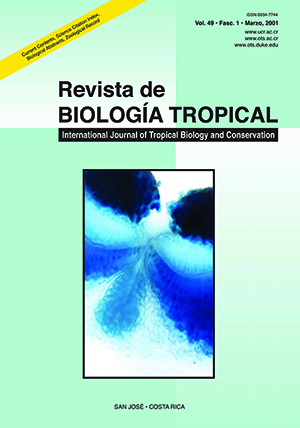Abstract
The diets of four diurnal fish species (Creagrutus bolivari, Knodus deuterodonoides, Knodus sp. and Poecilia reticulata) were examined during a year in the Orituco stream at northern Venezuela. The fishes were sampled monthly from February 1991 to March 1992 (except October 1991 and February 1992) in the stream main channel with a beach seine and a cast net. Diet is reported as frequency of ocurrence and numeric proportion because variation in prey sizes was small. Non-parametric statistical tests were applied. A total of 18 distinct prey items were found in stomachs. The diet of these fishes consisted of aquatic insects (Coleoptera, Diptera, Hemiptera, Odonata, Plecoptera and Trichoptera), allochthonous plant matter (fragments of leaves and seeds), microalgae (Chlorophyta and Bacillariophyceae) and terrestrial arthropods (Coleoptera, Diptera, Hymenoptera and Arachnida). The low percentage of empty guts and the high fullness percentage of guts suggest that food was always abundant. Aquatic insects were more important in the dry season (November - April) while plant matter and terrestrial arthropods increased in the wet season (May - October). The Proportional Similarity Measure (PS) was high between characid species and low between characids and P. reticulata in the dry season. PS decreased during the wet season because of a reduction in aquatic insect consumption. The seasonal diet shift indicated the greater importance of allochthonous food only in the wet season.##plugins.facebook.comentarios##

This work is licensed under a Creative Commons Attribution 4.0 International License.
Copyright (c) 2001 Revista de Biología Tropical
Downloads
Download data is not yet available.


